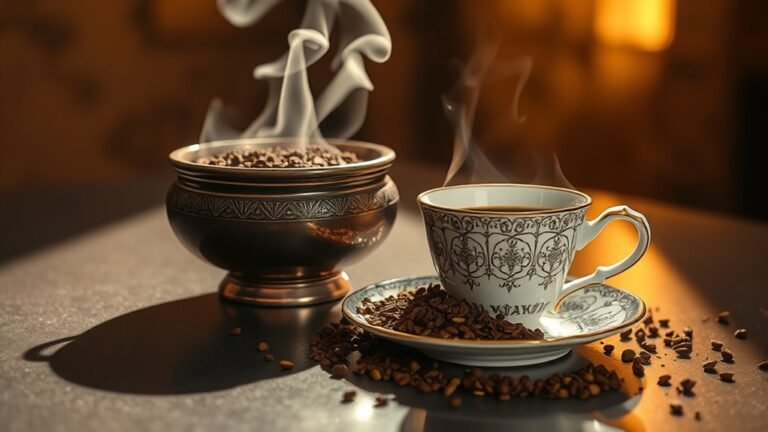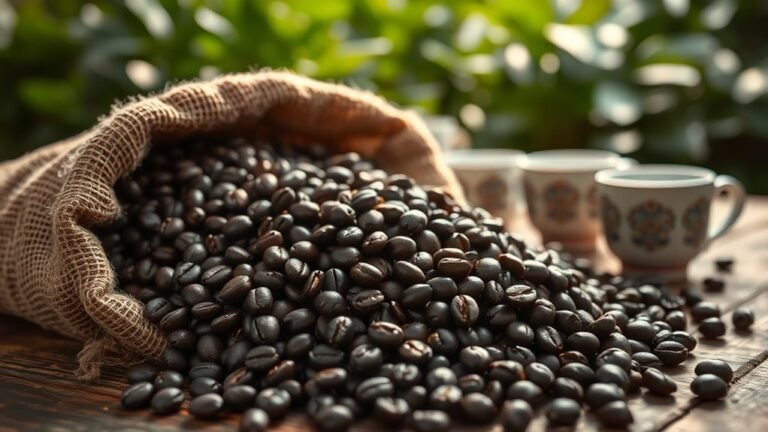The Best Coffee for Cowboy Coffee
For the best cowboy coffee, choose freshly roasted beans from the last 7 to 14 days, preferably medium to medium-dark roast to balance robustness and nuanced flavors. Opt for origins with bold profiles like Colombian or Sumatran beans. Use a coarse, uniform grind to minimize sediment and optimize extraction. Store beans airtight, away from light and heat, and grind just before brewing. Mastering these details guarantees strong, clean coffee — and there’s more to perfecting your cup ahead.
Understanding Cowboy Coffee Brewing Method

Although cowboy coffee brewing seems straightforward, mastering its technique requires understanding the precise water-to-coffee ratio, ideal grind size, and temperature control. You’ll want to use a coarse grind to avoid excessive sediment, while maintaining a brewing technique that balances extraction and clarity. Aim for a coffee ratio of about 1:15—one part coffee to fifteen parts water—for peak strength without bitterness. Heat your water just below boiling, around 200°F, to prevent scorching the grounds. After adding coffee grounds to hot water, let it steep for about four minutes, then remove from heat and allow grounds to settle before pouring. By refining these brewing techniques and coffee ratios, you gain freedom to craft a robust, clean cup anywhere, embodying the true spirit of cowboy coffee.
Ideal Roast Levels for Cowboy Coffee
When choosing roast levels for cowboy coffee, you’ll want to weigh how light and dark roasts influence extraction and flavor intensity. Light roasts preserve acidity and complex notes, while dark roasts emphasize bitterness and smokiness, both affecting your brew’s balance. Also, using freshly roasted beans is essential since oxidation can dull these nuanced profiles, impacting overall taste.
Light Vs Dark Roast
Since cowboy coffee relies on direct boiling of grounds in water, the roast level greatly impacts extraction and flavor. Light roast beans retain more acidity and origin characteristics but can result in a harsher brew when boiled directly. Dark roast beans, being oilier and more soluble, extract more evenly under high heat, yielding a smoother, bolder cup ideal for cowboy coffee’s robust style. Choosing between light and dark roast depends on your preference for clarity versus body.
| Aspect | Light Roast | Dark Roast |
|---|---|---|
| Acidity | Higher, bright notes | Lower, muted |
| Solubility | Less soluble, slower extraction | More soluble, faster extraction |
| Oil Content | Low | High |
| Flavor Stability | Sensitive to over-extraction | More forgiving |
| Ideal for Cowboy | Less ideal | More ideal |
Flavor Profiles Impact
Because cowboy coffee involves boiling grounds directly in water, understanding how flavor profiles interact with roast levels is crucial to achieving your desired cup. Darker roasts tend to emphasize bold, smoky aromatic profiles, which stand up well to the extended contact with hot water, minimizing bitterness while enhancing body. Lighter roasts preserve delicate flavor nuances—fruity, floral, or acidic notes—that can be overshadowed by the brewing method’s intensity. When selecting your roast, consider that medium to medium-dark roasts strike a balance, delivering pronounced aromatic profiles without sacrificing subtle flavor complexities. By mastering these interactions, you guarantee your cowboy coffee retains clarity and depth, matching your preference for a robust yet nuanced brew that complements the freedom and simplicity the method embodies.
Roast Freshness Importance
Although roast level greatly influences flavor, the freshness of your coffee beans plays an equally critical role in cowboy coffee. You need to prioritize the roast date, as coffee begins to lose its ideal flavor and aromatic compounds soon after roasting. The freshness criteria for cowboy coffee demand beans roasted within the last 7 to 14 days to guarantee maximum extraction and boldness in your brew. Stale beans produce dull, flat results, undermining the simplicity and robustness you seek.
Consider these factors when choosing your beans:
- Check the roast date on the packaging—avoid anything older than two weeks.
- Store beans in airtight containers away from light and heat to preserve freshness.
- Grind just before brewing to maintain volatile oils critical for cowboy coffee’s character.
Mastering freshness lets you brew with true freedom and flavor.
Choosing the Right Coffee Bean Origin
When selecting coffee beans for cowboy coffee, you’ll want to contemplate the origin, as it directly influences flavor complexity and acidity levels. Beans from regions like Ethiopia offer bright, fruity notes, while those from Brazil provide a nuttier, chocolatey profile ideal for bold brewing methods. Understanding these regional characteristics helps you pick the best beans that complement cowboy coffee’s robust, straightforward extraction.
Popular Coffee Bean Origins
Coffee bean origins greatly influence the flavor profile and strength of your cowboy coffee. Selecting beans from distinct regions guarantees you control the robustness and character of each brew. Here are three popular origins to take into account:
- Ethiopian beans: Known for their bright acidity and complex floral notes, these beans bring a lively, vibrant touch to your coffee, enhancing clarity and depth.
- Colombian beans: These offer a balanced, medium body with nutty and caramel undertones, providing a smooth yet bold cup that holds up well to the strong extraction in cowboy coffee.
- Sumatran beans: With earthy, full-bodied qualities and low acidity, these beans contribute a heavy, rich mouthfeel perfect for an intensely flavored brew.
Choosing your coffee bean origin lets you embrace freedom in flavor and strength, tailoring your cowboy coffee to your exact preference.
Flavor Profiles by Region
Since the origin of your coffee beans directly determines the chemical composition and flavor compounds present, understanding regional profiles is essential for crafting cowboy coffee that meets your taste expectations. Coffee terroir—encompassing soil minerals, altitude, climate, and microflora—profoundly influences bean acidity, body, and aromatic complexity. For example, East African regional varieties, like Ethiopian beans, deliver bright citrus and floral notes due to high-altitude volcanic soils. Conversely, Central American beans often exhibit balanced acidity with chocolate and nutty undertones, courtesy of their temperate climates. South American coffees typically offer mild acidity and a heavier body, reflecting their diverse altitudes and soil types. By selecting coffee beans from specific terroirs aligned with your desired flavor profile, you gain precise control over the boldness and nuances in your cowboy coffee, ensuring a brew that liberates your palate.
Best Beans for Brewing
Selecting the right coffee bean origin is essential for brewing cowboy coffee that matches your flavor preferences and brewing method. The choice directly impacts extraction, body, and aroma, especially since cowboy coffee lacks filtration. Consider these bean varieties:
- Ethiopian beans: Known for fruity and floral notes, ideal if you prefer a brighter cup with complex acidity.
- Guatemalan beans: Offer a balanced profile with chocolate and spice undertones, complementing robust brewing techniques.
- Sumatran beans: Provide earthy, full-bodied flavors with low acidity, perfect for longer brewing times typical of cowboy coffee.
Each origin interacts differently with your brewing technique, so select beans that harmonize with your method and desired strength. This precision guarantees you capture the essence of true cowboy coffee freedom in every cup.
Importance of Grind Size in Cowboy Coffee

Although cowboy coffee relies on a simple brewing method, the grind size plays a critical role in extraction efficiency and final taste. You need a coarse grind to prevent excessive sediment while ensuring adequate surface area for ideal extraction. Achieving uniform grind consistency is essential; uneven particles cause over-extraction of fine grounds and under-extraction of coarse bits, leading to bitterness or weak flavor. Utilize burr grinders or controlled manual grind techniques to maintain particle size uniformity. Since cowboy coffee involves boiling grounds directly, a coarse, consistent grind minimizes unwanted bitterness and sludge. Mastering grind size gives you freedom from pre-packaged filters and machines, letting you craft a robust, clean cup that captures the essence of true cowboy coffee tradition.
Freshness and Storage Tips for Cowboy Coffee Beans
Grinding your coffee beans to the right coarseness only matters if the beans themselves are fresh and properly stored. Maintaining peak bean freshness is critical for preserving the volatile oils that define flavor and aroma in cowboy coffee. To guarantee your beans remain potent and free from staleness, implement strategic storage methods. Store your beans in airtight containers, away from light, heat, and moisture, to inhibit oxidation. If you’re planning ahead, consider freezing beans in small portions to minimize exposure during repeated use. Remember, only grind your beans immediately before brewing to lock in freshness and flavor intensity. Key storage tips include:
- Use opaque, airtight containers to block oxygen and light.
- Keep beans in a cool, dry place, avoiding temperature fluctuations.
- Freeze excess beans in small batches for extended freshness without degradation.
These methods empower you to brew cowboy coffee with maximum flavor freedom.
Enhancing Flavor: Additives and Brewing Tips
When you want to elevate the bold, robust character of cowboy coffee, subtle additives and precise brewing techniques can make a significant difference. Start by experimenting with spice blends—cinnamon, cardamom, or clove—added directly to the grounds before boiling; this infuses complex aromas without overpowering. Use natural sweeteners like raw honey or maple syrup post-brew to balance bitterness while preserving authenticity. For brewing, verify water temperature is just off boil (about 200°F) to avoid scorched flavors, and allow grounds to settle by resting the pot after simmering. Stir gently to mix spices evenly, then pour slowly to minimize sediment in your cup. These controlled adjustments let you harness freedom in flavor while respecting cowboy coffee’s traditional essence.
Frequently Asked Questions
Can I Use Instant Coffee for Cowboy Coffee?
You can use instant coffee for cowboy coffee, but it won’t deliver the robust cowboy coffee flavors you might expect. Instant coffee simplifies brewing but lacks the depth and richness of freshly ground beans. If you want better taste, consider instant coffee alternatives like coarsely ground dark roast or French roast beans, which enhance flavor and provide a more authentic cowboy coffee experience while still embracing your freedom to brew anywhere.
What Equipment Is Essential for Making Cowboy Coffee?
Did you know 70% of coffee enthusiasts prefer manual brewing methods for control? For cowboy coffee, your essential gear includes a sturdy pot or kettle and a heat source like a campfire. Use a coarse grind size to prevent grounds from passing through. This brewing method relies on boiling water mixed directly with grounds, so a fine mesh strainer or letting grounds settle helps. Mastering this gives you freedom to brew anywhere, anytime.
How Long Should Cowboy Coffee Steep Before Serving?
When you steep cowboy coffee, aim for a steeping time of about 4 to 5 minutes. This duration balances extraction, ensuring the grounds release rich flavors without becoming overly bitter. Unlike other brewing methods that rely on filters, cowboy coffee uses direct immersion, so precise timing is essential. Stick to this steeping time to enjoy a strong, robust cup that honors the freedom and simplicity this brewing style embodies.
Is Cowboy Coffee Suitable for Espresso Machines?
You shouldn’t use cowboy coffee grounds in an espresso machine because espresso extraction requires finely ground coffee and precise pressure control, unlike the coarse grind and open brewing technique of cowboy coffee. Cowboy coffee relies on immersion and boiling, which doesn’t align with espresso’s pressurized brewing techniques. If you want freedom in your coffee, stick to the right grind and equipment for each method to guarantee the best extraction and flavor without risking machine damage or poor results.
Can I Make Cowboy Coffee Without a Campfire?
When it comes to making cowboy coffee, you don’t always have to rely on a campfire. There are plenty of campfire alternatives, like stovetop methods, that let you brew just as well indoors or elsewhere. Using a pot on a gas or electric stove, you can boil water and steep coarse coffee grounds precisely. This approach gives you control over temperature and timing, so you’re not tied down by firewood or weather—true freedom in your coffee-making.






